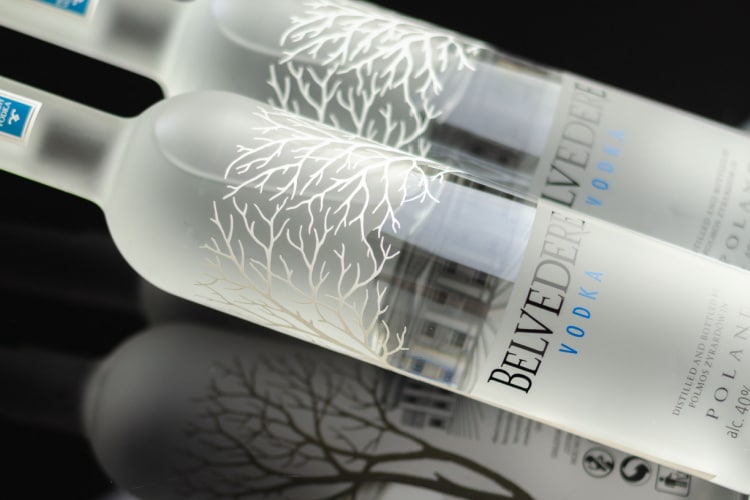The average pH of vodka is typically near neutral, around 6.0 to 7.0.
This is because vodka is distilled and filtered to remove impurities and flavors, resulting in a product that is mostly water and ethanol. Both have neutral pH values (pure water has a pH of 7, and the pH of pure ethanol is about 7.33).
However, the precise pH can vary slightly depending on certain factors, such as the brand and production process.

When is a Vodka Considered Acidic?
A vodka is considered acidic if its pH value falls below 7, which is the neutral point on the pH scale.
However, since vodka is generally meant to be a neutral spirit, manufacturers typically strive to keep the pH as close to neutral as possible.
If the pH of a particular vodka were significantly below 7, say around 4 to 6, it could be considered acidic. Here are a few examples of vodka brands and their pH:
Smirnoff – pH 6.0

This popular vodka brand is distributed by Diageo. Testing shows Smirnoff to have a pH right around 6, leaning slightly acidic.
Tito’s – pH 6.2

Tito’s Handmade Vodka is produced in Austin, Texas. It has a pH of 6.2, landing pretty close to neutral.
Ketel One – pH 5.8

Owned by Nolet Distillery in the Netherlands, Ketel One tests on the more acidic end of major vodka brands, with a pH of 5.8.
Belvedere – pH 6.4

Belvedere vodka by LVMH has an alkalinity level slightly higher than neutral, with a published pH of 6.4.
Grey Goose – pH 6.2

Bacardi’s premium Grey Goose vodka comes in right around 6.2 pH. So it’s very mildly acidic.
What are the Factors That Affect the Acidity of Vodka?
Here is what can control the pH of your vodka:
Water Source and Mineral Content
The water source is crucial in determining the pH level of vodka brands. Alkaline water or one with a high pH can result in vodka with alkaline pH values.
Conversely, a source with low pH or more acidic substances like citric acid can make vodka lean towards the acidic side.
Minerals in water, such as calcium, also play a role in buffering and can impact the final acidity or alkalinity of the spirit. Neutral spirits like vodka aim for a balanced pH, but the mineral content of the water source can tip this delicate balance.
Distillation Process
During distillation, vodka is distilled multiple times to achieve a neutral spirit; however, the process can influence the pH.
Pot stills used in traditional Eastern European methods might leave trace compounds that slightly affect acidity.
Moreover, the neutral quality of vodka minimizes the presence of acidic compounds, aiming to ensure the final beverage has a neutral pH level.
Yet, the efficiency of the distillation process in removing these acidic elements will dictate whether the vodka has a slightly acidic or more alkaline profile.
Type of Grains or Other Materials Fermented
Vodka can be created from different materials, such as wheat, rye, corn, or potatoes. Each grain has its own pH level and may impart a slight acidity to the mash.
For instance, rye may result in a vodka that is more acidic compared to wheat which leads to a more neutral profile.
The initial acidic conditions favored by the yeast during fermentation can influence the pH of the distilled vodka, although most acidic elements are removed during distillation.
Fermentation Conditions
The environment in which fermentation takes place affects the acidity of the resulting vodka.
Factors such as temperature, duration, and yeast strain can create varying pH levels within the fermenting liquid.
While the goal is to produce a neutral spirit, these conditions can lead to the production of acidic by-products such as acetic or lactic acid.
However, the distillation process aims to remove these acidic compounds to maintain a neutral vodka pH level.
Additives or Flavoring Agents
The addition of flavoring agents to vodka can significantly alter its pH. Ingredients like lemon juice, citric acid, or other fruits that are acidic can lower the vodka’s pH level.
Conversely, alkaline additives can raise the pH level. Flavored vodkas, therefore, often have a more acidic or more alkaline pH than traditional, unflavored vodka, which is typically a neutral spirit.
Storage Conditions
Storage conditions such as exposure to air or temperature can affect vodka’s pH. Interaction with carbon dioxide from the air can form carbonic acid, making the vodka more acidic.
This is similar to what happens when club soda is left open. Properly sealed and stored vodka maintains a consistent pH level, keeping it on the neutral side.
Interaction with Carbon Dioxide from the Air During Storage or Serving
When vodka is exposed to air, it can absorb carbon dioxide and form a weak carbonic acid, slightly lowering the pH and making it more acidic.
Ensuring airtight storage can thus help in maintaining the desired neutral pH levels in vodka, keeping it away from the acidic spectrum.
Aging Process (if applicable)
Vodka is typically not aged, but if it were to undergo an aging process, the pH might shift. Interactions with the glass or wood from barrels could introduce acidic substances that alter the pH level.
However, as vodka is a neutral spirit, most brands do not use an aging process that would significantly affect its pH balance, keeping it away from the acidic side of the pH scale.
Final Words
In summary, while vodka has a pH that’s near neutral, brand variations and production nuances can make some vodka slightly acidic.
Factors such as water sources, distillation methods, and added flavors play significant roles in the final pH of vodka, but typically, it remains close to neutral, providing a smooth, clean taste.